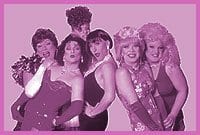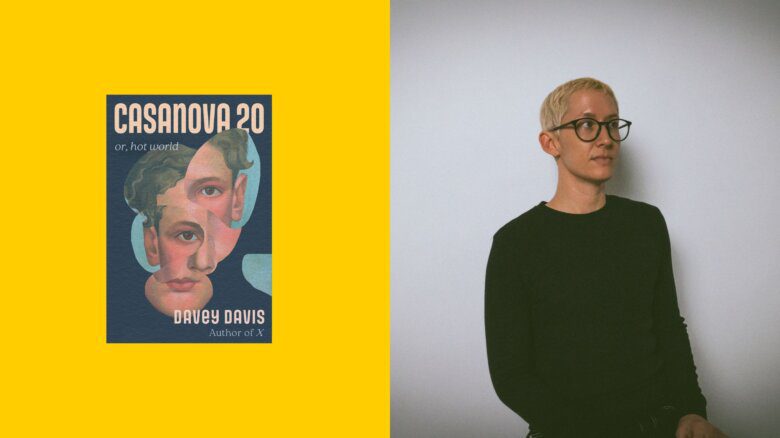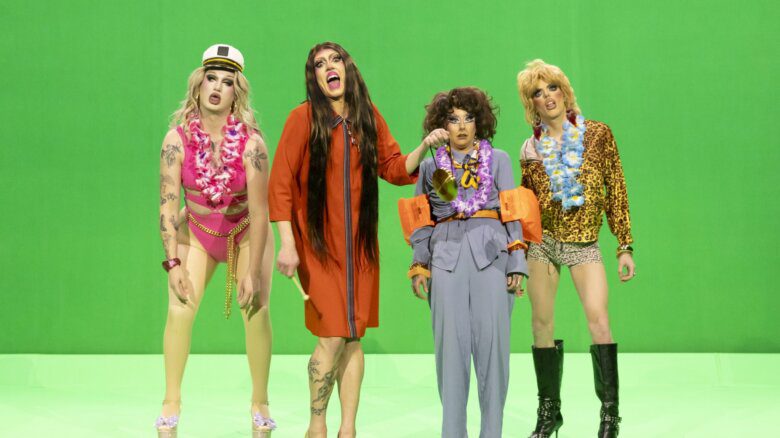Rusty Ryan, patron saint of drag, surely smiles down at us from the great hairafter; crocuses bloom, the robins return and the queens are teasing their Easter wigs in preparation for DQ ’04. Now an annual event, DQ is spreading its wings under the creative influence of returning writer/director Graham Maxwell as he introduces plot and scripting to the guys in gowns.
Ryan, who delighted in touring his infamous drag shows throughout northern Ontario, would undoubtedly be thrilled at the play’s setting in Nipissing, where our heroines compete in a drag contest for the chance to travel to Toronto for the big DQ pageant.
This will be the seventh outing for DQ (running Thu, Apr 1 to 10 at Buddies), which first sprang out of the theatrical closet in 1987. Replacing the previous format of short set pieces with a scripted plot seemed a natural progression for Maxwell, as did the move to a larger venue at Buddies In Bad Times Theatre from last year’s Hart House Theatre where Maxwell first took over the creative reins to hilarious effect.
“You need to mix things up a bit, or they go stagnant,” says Maxwell, explaining his decision to stage this year’s production as a full-fledged play. “I like a [drag] review, but I don’t think audiences are tolerant anymore to just sitting and watching one.”
He began by taking a plot outline to Carl Blendheim, who then wrote a treatment that Maxwell could mould into a workable production. “Carl’s the guardian angel smiling over all of us,” he says. Suspecting that DQ’s fundraising power wasn’t reaching its full potential, Maxwell decided that staging the event annually would reinforce its place in the public consciousness, helping it grow in awareness and attendance each year.
It was the queens themselves who inspired their roles in the play, by virtue of their own quirks and personalities – and they’ve got plenty to spare. Maxwell worked with each performer to create personas aside from their regular drag shtick, fleshing out each character and exploring the importance of drag to them. “All ideas are open to the floor,” he says; any member in the production had input into dialogue and staging.
“Drag queen is like a musical instrument,” says Maxwell, citing the challenges facing each actor. “They’re supposed to be feminine and musical even when they’re speaking.”
The first act of the play introduces us to the queens, as we find out where they come from (for example Miss Big Nickel from Sudbury) and why they want to represent their region at DQ. The second act is the pageant itself – a good old-fashioned drag show, with “tits, teeth and tokus.” Musical numbers will showcase lip-synching as well as live singing, with spirited comedy and dance routines to round out the evening’s entertainment.
Veteran dragster Candi Barr (David Clark) plays against type as Daphne Do-Dah-Day, a klutzy no-talent with Elke Sommer’s hair and Elly May Clampett’s evening gown. “David is a sweetheart, but not as saccharine as Daphne is in this,” says Maxwell.
Clark’s antics in rehearsal cause frequent fits of laughter among his cast mates, obviously delighting in his gift for physical comedy. One dance number finds Daphne spread-eagled on the floor, writhing about like Esther Williams in dry dock. The cast barely gets through this bit, as they roar with laughter at Clark’s deadpan performance.
The delightful Hollywood (Richard Cripps) moves majestically through the numbers, her boisterous laughter filling the room as she gamely follows Maxwell’s direction. “I like the funny, campy stuff,” says Cripps, explaining what drew him to DQ this year. “If I can make someone laugh, then I’ve done my job.” Some may recall Cripps’ showstopper from last year in an ugly-inducing skintight gold lamé body suit.
There are a few professionals among the cast, but the majority of DQ-ers are amateur performers, eager for some time in the spotlight. Old pros are easy to spot in their utilitarian sweats during rehearsals, while the young ingénues strut about proudly in full gear.
Most productions have their share of attitude clashes, but Maxwell is pleasantly surprised that such contre-temps have been kept to a minimum.
Every show, however, has its prima donna. One of the performers dressed as Dolly Parton’s chunky Canadian cousin haughtily refused to be interviewed (“Oh honey, not now!”), only to return an hour later for her moment in print. Well, honey, not in this article.
Small indignities aside, it is clear this cast enjoys each other with genuine camaraderie and good humour. Maxwell is an indulgent and patient shepherd, and his femme flock clearly thrives under his firm but affectionate direction. “It’s one big family,” says Hollywood. “DQ is a family thing.”
For seasoned theatre actor Brad Cormier (Cats, Phantom Of The Opera), the charity’s the thing. Proceeds from DQ ’04 are earmarked for Casey House, and he is happy to help out in any way he can. This is Cormier’s third DQ, and he takes any amateur glitches in stride. “You only work as fast as the slowest person,” he says, “but you just sit back and relax. Everyone is really focussed and dedicated.”
“I love any scene Roxxie Teraine is in,” says Maxwell, referring to Cormier’s drag persona. “Brad is wonderful.”
Producer Marlene Smith admits that working with the amateur production is, “a change from the pros… because they’re all volunteer, they’re not in fear of losing their jobs.” After producing shows like Cats and It’s Always Something, Smith admires the dedication of everyone involved. “It’s a commitment, there’s no question,” she says of the actors and staff giving so many hours to the pageant.
Cast members and the production crew repeatedly mention Casey House. It’s clear that raising money for the renowned Toronto AIDS hospice is the driving force behind hours of donated time.
From wardrobe staff to usherettes, lending a hand to help the venerable institution is uppermost in their minds.
It’s refreshing to see a broad spectrum of ages and demeanours involved behind the scenes and onstage. One septuagenarian siren gamely claps along in a dance number, nimbly going through the steps alongside queens a third her age. Another femme d’un certain âge repeats her lines over and over, eager to get them right, and basking in the laughter of those watching.
There is an atmosphere of bonhomie that keeps the energy crackling during the long rehearsals. The girls help each other in and out of wigs and dresses, with affection and good-natured teasing. Laughter streams from the dressing area, while amiable chatter floats out from the makeshift sewing room. This happy buzz seems pleasantly at odds with the stereotype of the catty queen, and is the soul of DQ’s universal appeal.
Aside from the glamour, the laughs, the songs and the spectacle, the truth is that everyone involved in DQ is here for one common cause – to give back to the hospice which has meant so much to their community for the last 16 years.
“As long as the audience has a good time,” says Maxwell, summing up his hopes for the show. “The Pulitzer committee ain’t comin’ to this one.”

 Why you can trust Xtra
Why you can trust Xtra


